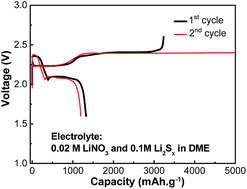Demonstration of highly efficient lithium–sulfur batteries
Abstract
Lithium–sulfur coin cells were tested with the aim of mitigating the issue of polysulfide dissolution. Five approaches were investigated: optimization of the amount of sulfur that can be contained in the sulfur/carbon electrodes, introduction of different forms of carbon additives into the sulfur electrodes, impregnation of sulfur into the pores of high-surface-area carbon via a melting process, addition of high-surface-area TiO2 as a polysulfide-adsorbing agent in the sulfur electrodes, and use of lithium nitrate as an additive in the electrolyte. Among all these approaches, the most effective way to inhibit the shuttle phenomenon and improve the coulombic efficiency of the Li–S battery was the addition of LiNO3 into the electrolyte.

- This article is part of the themed collection: Flexible energy storage and conversion

 Please wait while we load your content...
Please wait while we load your content...